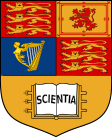
The Royal College of Chemistry (RCC) was a college originally based on Oxford Street in central London, England. It operated between 1845 and 1872.
The original building was designed by the English architect James Lockyer in 1846 with the foundation stone being laid by Albert, Prince Consort on June 16, 1846.[1][2]
The College was set up to teach practical chemistry. Many politicians donated funds to establish the college, including Benjamin Disraeli, William Gladstone and Robert Peel. It was also supported by Prince Albert.[2]
The first director was August Wilhelm von Hofmann. Frederick Augustus Abel studied under von Hofmann. Sir William Crookes, Edward Divers and J. A. R. Newlands also attended the college.
The young William Henry Perkin studied and worked at the college under von Hofmann, but resigned his position after discovering the first synthetic dye, mauveine, in 1856. Perkin's discovery was prompted by his work with von Hofmann on the substance aniline, derived from coal tar, and it was this breakthrough which sparked the synthetic dye industry, a boom which some historians have labelled 'the second chemical revolution'.[citation needed]
The college was merged into the Royal School of Mines in 1853. It was the first constituent college of Imperial College London and eventually became the Imperial College Chemistry Department.[3]
YouTube Encyclopedic
-
1/3Views:19 452258 920809 070
-
Martin Karplus discusses winning the Nobel Prize in Chemistry
-
Infrared spectroscopy (IR)
-
High Performance Liquid Chromatography HPLC
Transcription
References
- ^ "The Late Mr James Lockyer, architect", The Builder, 19 June 1875, p. 544.
- ^ a b "Royal College of Chemistry" (PDF). The BMJ. 10 (26): 307–308. 1 July 1846. ISSN 0959-8138. PMC 2559528. PMID 20794013. Wikidata Q58783003.
- ^ "Undergraduate Prospectus". Department of Chemistry. UK: Imperial College London. Archived from the original on 30 March 2014. Retrieved 30 March 2014.
External links
- Site of the Royal College of Chemistry — 22 May 2003, Oxford Street, London
- Chemistry at Imperial College: the first 150 years
- Royal College of Chemistry (Great Britain)
51°30′53″N 0°08′42″W / 51.5147°N 0.1449°W

